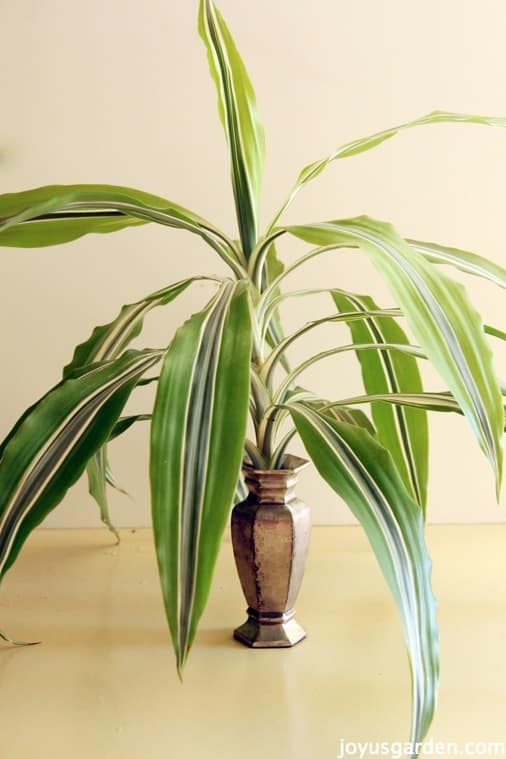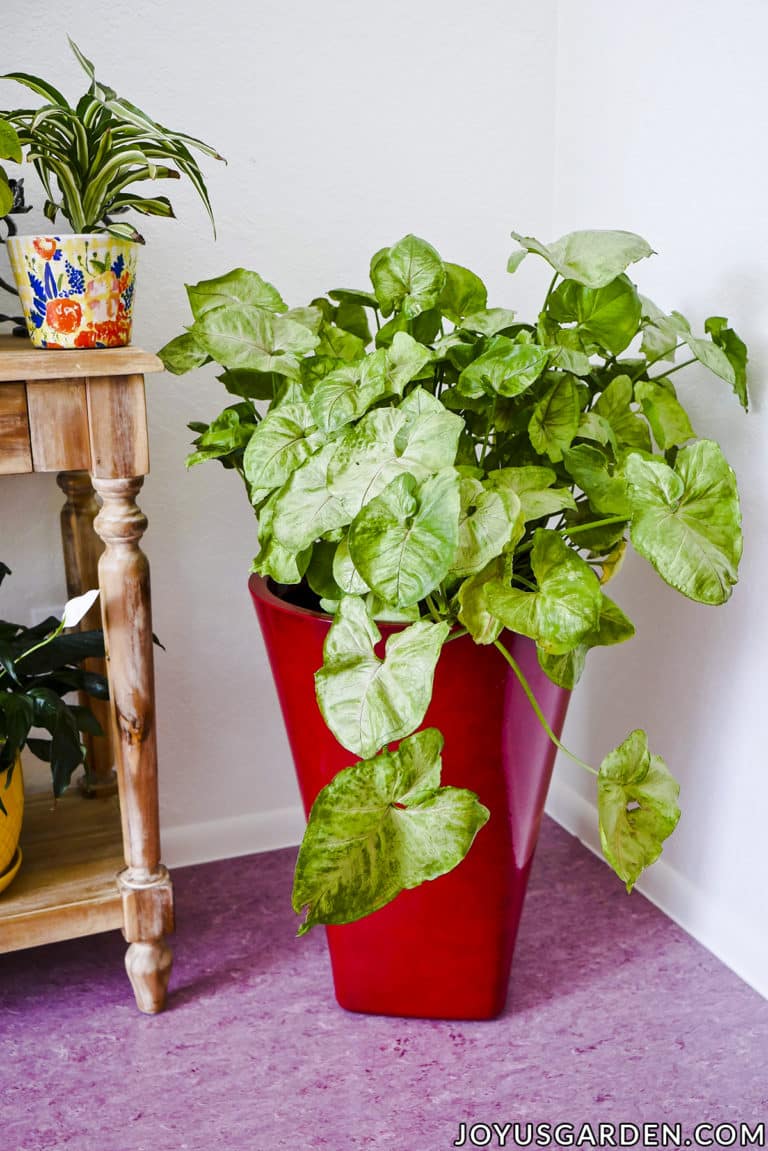Dracaena Song Of India Care & Growing Tips: The Plant With Vibrant Foliage
I first saw a Dracaena reflexa, then called Pleomele reflexa, when I was working as an interior plantscaper in Boston. We didn’t get many in from the grower in Florida but I’ve always loved this plant. It develops an interesting somewhat twisted form as it grows which adds to its appeal. I’ve been growing Dracaena reflexa Song Of India for many years and want to share these care tips with you.
You’ll see this plant sold as Song Of India, Dracanea Song Of India or Dracaena reflexa Song Of India. It has vibrant chartreuse foliage (that I just love!) which needs a good amount of natural light to sustain. If you’ve followed me here or on social media you know how plants with chartreuse foliage knock my socks off.
A few specifics:
Size
You most often see these for sale as smaller plants in 6″ or 8″ grow pots which are tabletop plants. When you get into the 10″, 12″ & 14″ grow pot size, those are floor plants. The tallest I’ve seen a Song Of India as a houseplant is 6′.
Growth Rate
Slow to moderate. The more light it gets, the faster it’ll grow.
Uses
Like many houseplants, this is a tabletop plant as well as a floor plant. Mine is 18″ tall right now & sits on a small chest. Over the years it’ll grow into a floor plant as long as it gets strong natural light & is repotted every 2-3 years.
Close Relatives
The ones I’ve seen are the Dracaena reflexa, which has darker foliage & the Song Of Jamaica, which is medium green edged in yellowish white.

Here’s that vibrant chartreuse foliage up close.
Dracaena Song Of India care tips:
Exposure
The Song Of India is a medium to a high light houseplant. Mine is in my kitchen in an east/south exposure where a sliding patio door & a frosted skylight gives it a good amount of bright natural light all day.
I rotate it every couple of months so it gets the light evenly all the way around. Don’t let it get too much direct, hot sun or it’ll burn. And, don’t even try this plant in low light – it’ll be a no go.
If you’re in a less sunny climate, an east or west exposure is fine. Just keep it away from hot, sunny windows & direct afternoon sun. In the darker winter months, you might have to move yours to a location with more light to keep it happy.
Watering
I water mine & then let it dry out by at least 1/2 before watering again. Mine is currently in a 6″ pot & I water it every week (I’m in Tucson – a sunny, dry climate). In the winter months it’s every 2 weeks. Adjust this for your climate & the exposure, the size pot yours is in, & the soil mix.
Temperature
If your home is comfortable for you, it’ll be so for your houseplants too. Just be sure to keep your Dracaena Song Of India away from any cold drafts as well as air conditioning or heating vents.

This is what a mature Song Of India looks like.
Humidity
This plant is native to the tropics. Despite this, I’ve found them to be adaptable & do okay in our homes which tend to have dry air. Here in hot, dry Tucson mine is looking good so far after having it for a couple of years. My plant has a few small brown tips & that’s a reaction to the dry air.
If you think yours look stressed due to lack of humidity, then fill the saucer with pebbles & water. Put the plant on the pebbles but make sure the drain holes &/or the bottom of the pot aren’t submerged in any water. Misting a few times a week should help out too.
Fertilizing/Feeding
I’ve found that Song Of Indias aren’t that needy when it comes to feeding. Right now I feed all my houseplants with a light application of worm compost followed by a light layer of compost over that every spring. Easy does it – 1/4 to 1/2″ layer of each for a smaller sized plant. Read about my worm compost/compost feeding right here.
I can’t recommend a specific fertilizer because I’ve never used 1 for my Song Of India. Mine looks just fine so I have no need at the moment. That could change!
Whatever you use, don’t fertilize houseplants in late fall or winter – that’s their time for rest. Over fertilizing your Song Of India will cause salts to build up & can burn the roots of the plant. Be sure to avoid fertilizing a houseplant which is stressed, ie. bone dry or soaking wet.
Soil
Use a good organic potting soil when repotting this plant. You want it to be enriched with good stuff but also to drain well.
I’m partial to Ocean Forest & Happy Frog because of their high-quality ingredients. I use 1 & then the next time the other. Sometimes I combine them. They’re great for container planting, including houseplants.
I usually mix in a handful or 2 of pumice or perlite, & local organic compost. I do a good amount of planting & repotting so I keep a varied amount of soil materials on hand in my garage. The pumice & perlite aid in drainage & aeration & the compost enriches the mix.
Repotting/Transplanting
I’m repotting my Dracaena Song Of India this Spring. When I lift the plant up & look into the drain holes I can see the roots. It’s now in a 6″ pot & I’m transplanting it into an 8″ pot. I’ll be doing a post & video on this soon so stay tuned for that.
Yours will probably need repotting every 2 or so years depending on how it’s growing.

The canes, or stems, close up.
Propagation
It’s easy! Simply take end cuttings which are 6-12″ long. Make sure your pruners are clean & sharp when doing this. I’ve propagated always them in water. You can also do it in a light mix like a seed starting mix or succulent & cactus mix.
Pruning
This plant doesn’t grow fast so pruning really shouldn’t be necessary. If so, it’ll be for propagation &/or when the stems get too leggy. You can cut them down & sprouts will eventually appear towards the top of the stems. The parts you cut off can also be propagated.
Pests
The Song Of India can be susceptible to mealybugs, especially deep inside the new growth. That’s what happened to mine last year. These white, cotton-like pests like to hang out in the nodes & under the leaves. I simply blasted them off (lightly!) in the kitchen sink with the spray & that did the trick.
Also keep your eye out for scale & spider mites. It’s best to take action as soon as you see any pest because multiply like crazy. Pests can travel from houseplant to houseplant fast so make you get them under control pronto.
Pets
All dracaenas are considered to be toxic to pets. I consult the ASPCA website for my info on this subject – here’s more info on this for you.
Here are a few things good to know regarding your Song Of India plant:
They gradually lose the bottom leaves as the plant grows taller. It’s how the plant grows just like the Dracaena Lisa & Dracanea marginata.
The Song Of India develops into a cane or trunk form with time. As a small plant you may buy it with foliage up & down the stems but that changes with time.
If the “trunky” look isn’t for your thing, you can prune the top parts off & propagate. Just know that the plant won’t grow too much taller over time if you do that on the regular.
The tops of this plant really lean toward a light source. I rotate mine every couple of months.
Don’t keep it too wet or the roots will succumb to root rot. Roots need oxygen too.
The Song Of India is easiest to clean in sink or shower. Heat can blow a lot of dust around. The leaves of your plants need to breath & a build up of dust can prevent this. A damp, soft rag does the trick as well as a good spray off. And don’t use a commercial leaf shine – it blocks the pores.

You can see that the twisting form has started even on this smaller plant.
If the leaves of your plant are turning yellow, it’s most likely too dry. If the leaves are turning yellow/brown, it’s most likely too wet. Or, if the canes (stems) are mushy, it’s too wet. And remember, if the occasional lower leaf falls off, it’s just the nature of this plant and how it grows. If a lot of leaves are falling off, there’s a problem.
In Conclusion: To have success growing a Song Of India as a houseplant, you need to give it medium to high light. Many people fail with this plant because of low light and too much water. It needs to be planted in a mix which is aerated and drains well yet is rich.
If you like chartreuse foliage and have strong natural light, the Song Of India should be your next houseplant purchase. Don’t expect it too grow too fast though because it really takes its time. But my oh my, that new growth is vibrant and glowing!
Happy Gardening,

If you enjoyed learning more about the Dracaena reflexa plant, I think you’ll enjoy learning about more houseplants below:





